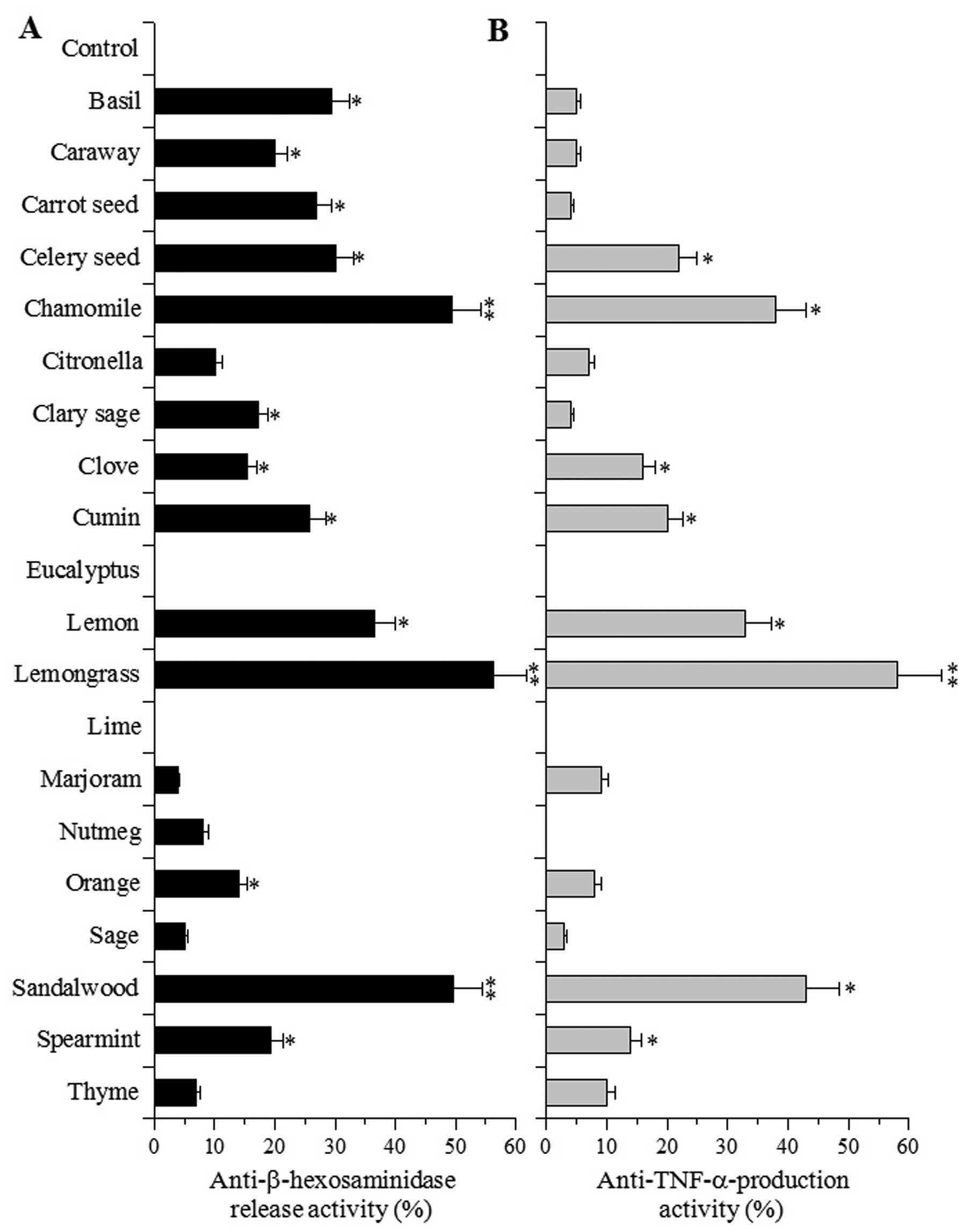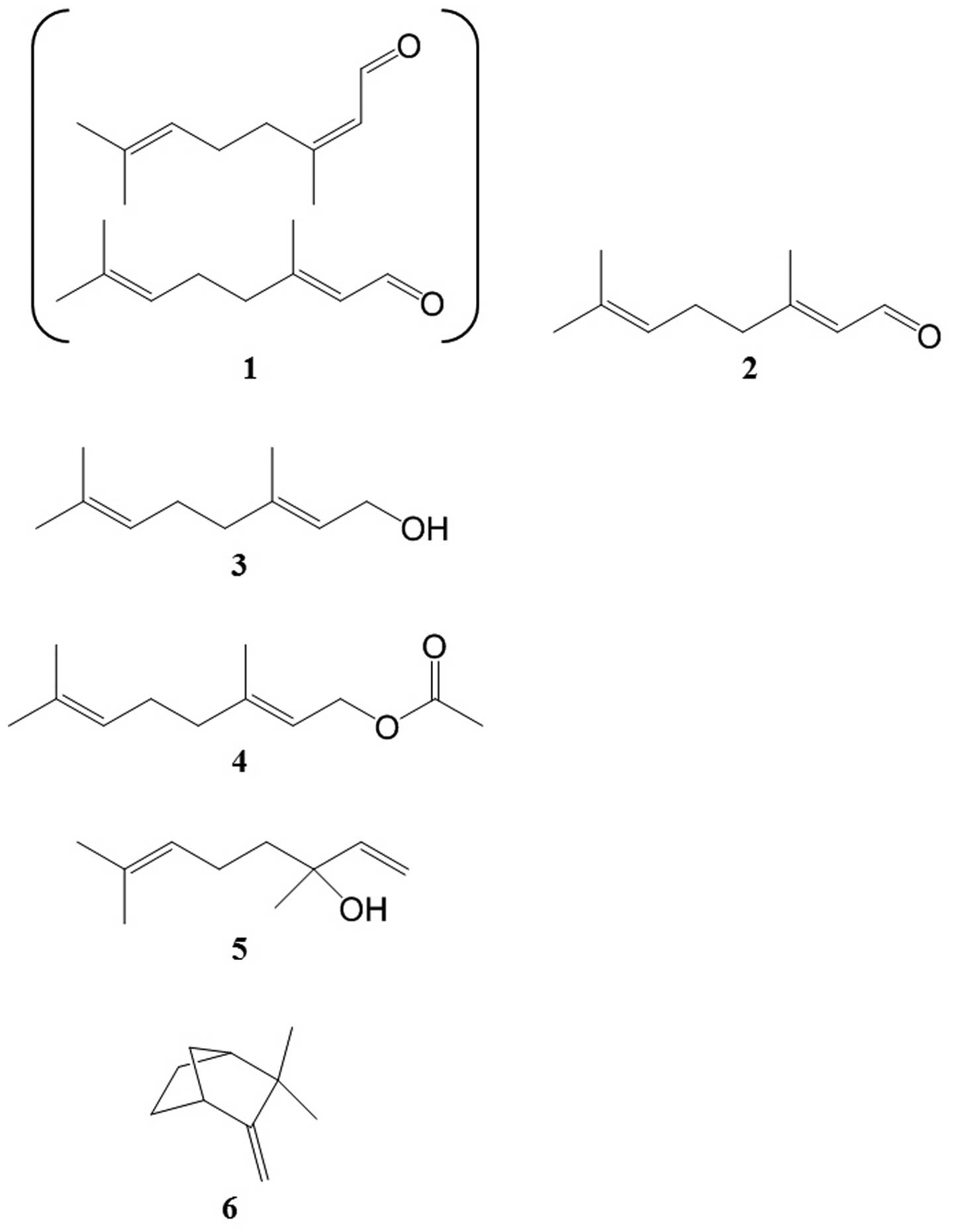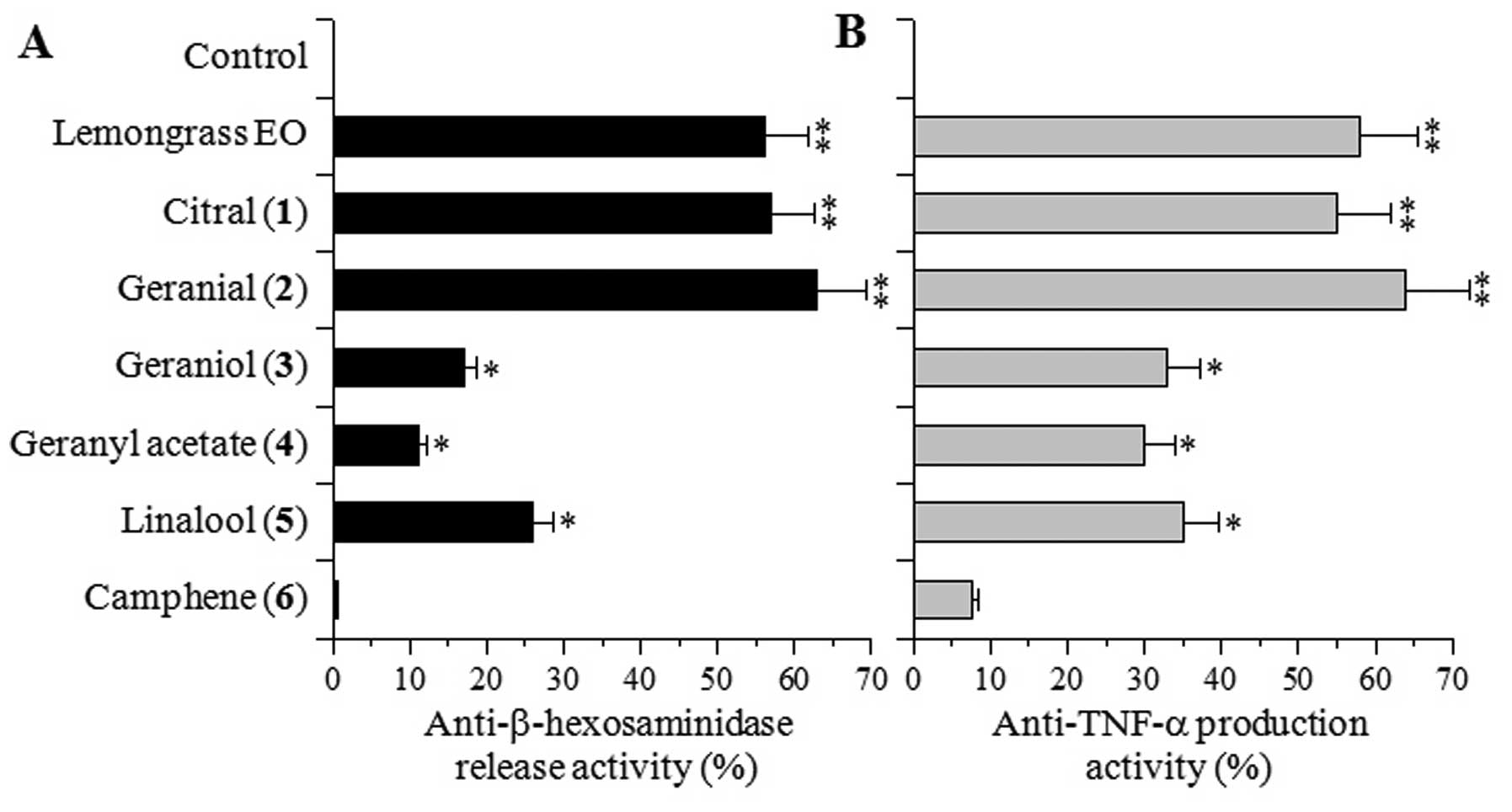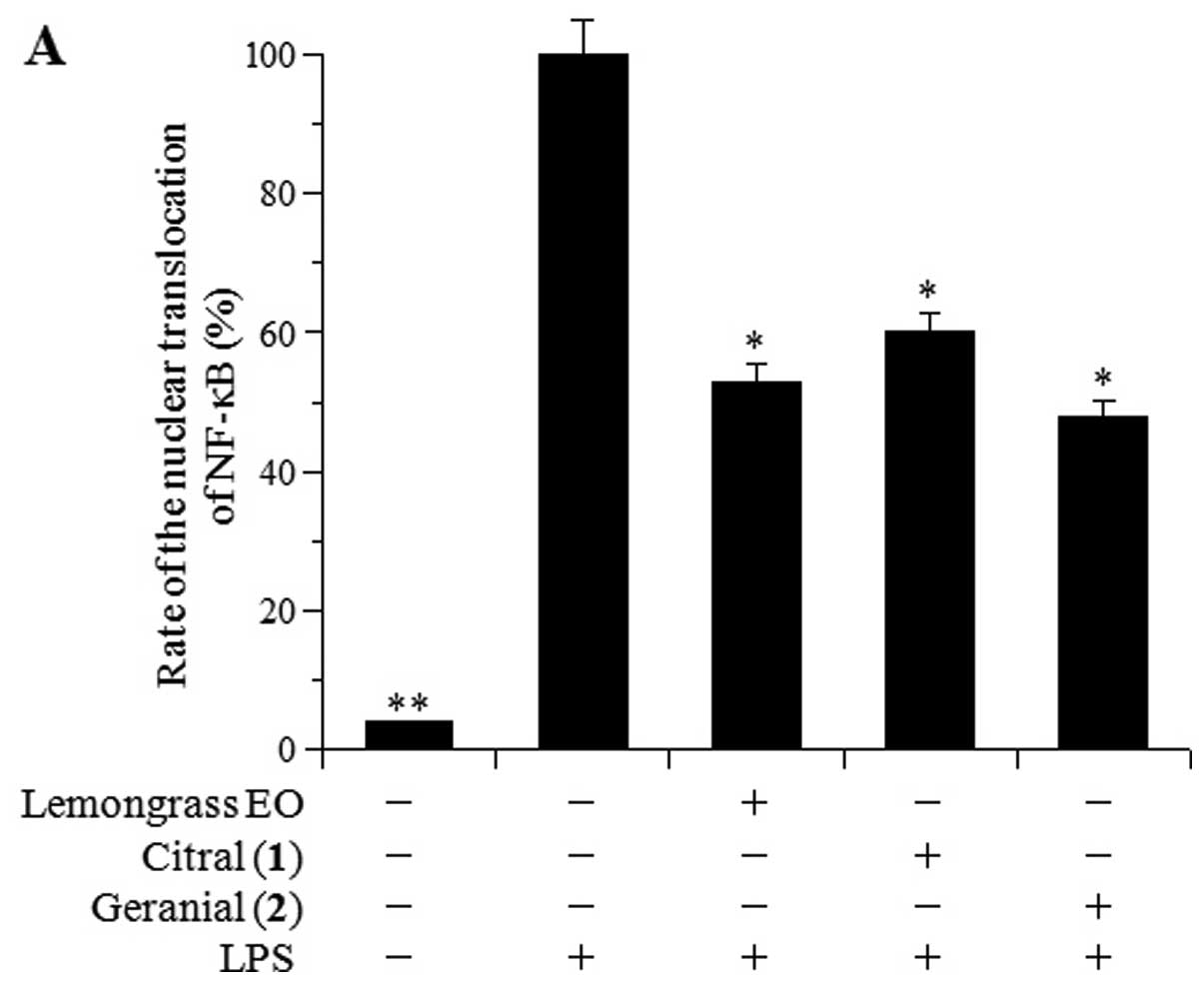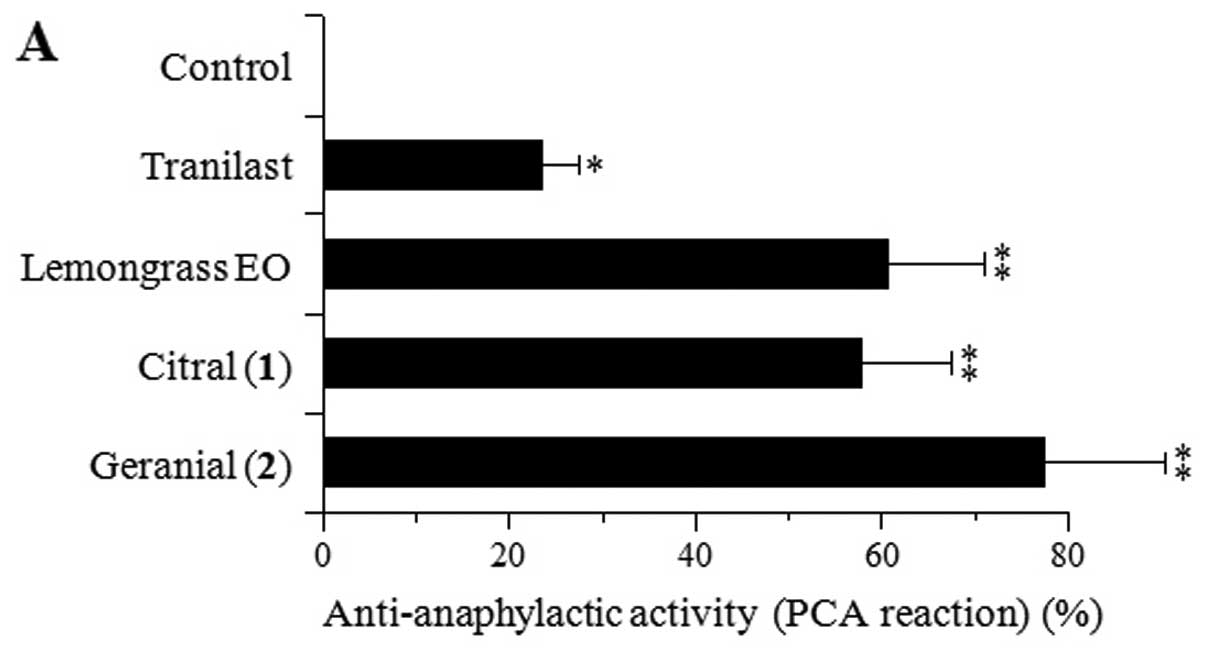|
1
|
Bakkali F, Averbeck S, Averbeck D and
Idaomar M: Biological effects of essential oils-a review. Food Chem
Toxicol. 46:446–475. 2008. View Article : Google Scholar : PubMed/NCBI
|
|
2
|
Woollard AC, Tatham KC and Barker S: The
influence of essential oils on the processå of wound healing: a
review of the current evidence. J Wound Care. 16:255–257. 2007.
|
|
3
|
Prabuseenivasan S, Jayakumar M and
Ignacimuthu S: In vitro antibacterial activity of some plant
essential oils. BMC Complement Altern Med. 6:392006. View Article : Google Scholar : PubMed/NCBI
|
|
4
|
Clarke JO and Mullin GE: A review of
complementary and alternative approaches to immunomodulation. Nutr
Clin Pract. 23:49–62. 2008. View Article : Google Scholar : PubMed/NCBI
|
|
5
|
Wüthrich B: Epidemiology of the allergic
diseases: are they really on the increase? Int Arch Allergy Appl
Immunol. 90(Suppl 1): S3–S10. 1989.PubMed/NCBI
|
|
6
|
Stevens RL and Austen KF: Recent advances
in the cellular and molecular biology of mast cells. Immunol Today.
10:381–386. 1989. View Article : Google Scholar : PubMed/NCBI
|
|
7
|
Plaut M, Pierce JH, Watson CJ, Hanley-Hyde
J, Nordan RP and Paul WE: Mast cell lines produce lymphokines in
response to cross-linkage of Fc epsilon RI or to calcium
ionophores. Nature. 339:64–67. 1989. View
Article : Google Scholar : PubMed/NCBI
|
|
8
|
Gordon JR, Burd PR and Galli SJ: Mast
cells as a source of multifunctional cytokines. Immunol Today.
11:458–464. 1990.PubMed/NCBI
|
|
9
|
Ronis MJ, Butura A, Korourian S, Shankar
K, Simpson P, Badeaux J, Albano E, Ingelman-Sundberg M and Badger
TM: Cytokine and chemokine expression associated with
steatohepatitis and hepatocyte proliferation in rats fed ethanol
via total enteral nutrition. Exp Biol Med (Maywood). 233:344–355.
2008. View Article : Google Scholar : PubMed/NCBI
|
|
10
|
Pierce GF: Macrophages: important
physiologic and pathologic sources of polypeptide growth factors.
Am J Respir Cell Mol Biol. 2:233–234. 1990.PubMed/NCBI
|
|
11
|
Boscá L, Zeini M, Través PG and Hortelano
S: Nitric oxide and cell viability in inflammatory cells: a role
for NO in macrophage function and fate. Toxicology. 208:249–258.
2005.PubMed/NCBI
|
|
12
|
Hirano M, Yakabe S, Chikamori H, Clark JH
and Morimoto T: Oxidation by chemical manganese dioxide. Part 3.
Oxidation of benzylic and allylic alcohols, hydroxyarenes and
aminoarenes. J Chem Res (S). 770–771. 1998. View Article : Google Scholar
|
|
13
|
Razin E, Mencia-Huerta JM, Stevens RL,
Lewis RA, Liu FT, Corey E and Austen KF: IgE-mediated release of
leukotriene C4, chondroitin sulfate E proteoglycan,
beta-hexosaminidase, and histamine from cultured bone
marrow-derived mouse mast cells. J Exp Med. 157:189–201. 1983.
View Article : Google Scholar : PubMed/NCBI
|
|
14
|
Sato H, Kobayashi Y, Hattori A, Suzuki T,
Shigekawa M and Jippo T: Inhibitory effects of water-soluble
low-molecular-weight β-(1,3-1,6) D-glucan isolated from
Aureobasidium pullulans 1A1 strain black yeast on mast cell
degranulation and passive cutaneous anaphylaxis. Biosci Biotechnol
Biochem. 76:84–88. 2012.
|
|
15
|
Nishiumi S, Yamamoto N, Kodoi R, Fukuda I,
Yoshida K and Ashida H: Antagonistic and agonistic effects of
indigoids on the transformation of an aryl hydrocarbon receptor.
Arch Biochem Biophys. 470:187–199. 2008. View Article : Google Scholar : PubMed/NCBI
|
|
16
|
Gschwendt M, Kittstein W, Fürstenberger G
and Marks F: The mouse ear edema: a quantitatively evaluable assay
for tumor promoting compounds and for inhibitors of tumor
promotion. Cancer Lett. 25:177–185. 1984. View Article : Google Scholar : PubMed/NCBI
|
|
17
|
Aggarwal BB: Signalling pathways of the
TNF superfamily: a double-edged sword. Nat Rev Immunol. 3:745–756.
2003. View
Article : Google Scholar : PubMed/NCBI
|
|
18
|
Hashimoto T, Nonaka Y, Minato K, Kawakami
S, Mizuno M, Fukuda I, Kanazawa K and Ashida H: Suppressive effect
of polysaccharides from the edible and medicinal mushrooms,
Lentinus edodes and Agaricus blazei, on the
expression of cytochrome P450s in mice. Biosci Biotechnol Biochem.
66:1610–1614. 2002. View Article : Google Scholar : PubMed/NCBI
|
|
19
|
Jacobs MD and Harrison SC: Structure of an
IkappaBalpha/NF-kappaB complex. Cell. 95:749–758. 1998. View Article : Google Scholar : PubMed/NCBI
|
|
20
|
Verma IM, Stevenson JK, Schwarz EM, Van
Antwerp D and Miyamoto S: Rel/NF-kappa B/I kappa B family: intimate
tales of association and dissociation. Genes Dev. 9:2723–2735.
1995. View Article : Google Scholar : PubMed/NCBI
|
|
21
|
Cheng SS, Lin HY and Chang ST: Chemical
composition and antifungal activity of essential oils from
different tissues of Japanese Cedar (Cryptomeria japonica).
J Agric Food Chem. 53:614–619. 2005. View Article : Google Scholar : PubMed/NCBI
|
|
22
|
Ksouri R, Falleh H, Megdiche W, Trabelsi
N, Mhamdi B, Chaieb K, Bakrouf A, Magné C and Abdelly C:
Antioxidant and antimicrobial activities of the edible medicinal
halophyte Tamarix gallica L. and related polyphenolic
constituents. Food Chem Toxicol. 47:2083–2091. 2009. View Article : Google Scholar : PubMed/NCBI
|
|
23
|
Lo Cantore P, Shanmugaiah V and Iacobellis
NS: Antibacterial activity of essential oil components and their
potential use in seed disinfection. J Agric Food Chem.
57:9454–9461. 2009.PubMed/NCBI
|
|
24
|
Dutra RC, Leite MN and Barbosa NR:
Quantification of phenolic constituents and antioxidant activity of
Pterodon emarginatus vogel seeds. Int J Mol Sci. 9:606–614.
2008. View Article : Google Scholar : PubMed/NCBI
|
|
25
|
Kumar A, Malik F, Bhushan S, Sethi VK,
Shahi AK, Kaur J, Taneja SC, Qazi GN and Singh J: An essential oil
and its major constituent isointermedeol induce apoptosis by
increased expression of mitochondrial cytochrome c and apical death
receptors in human leukaemia HL-60 cells. Chem Biol Interact.
171:332–347. 2008. View Article : Google Scholar
|
|
26
|
Chao LK, Hua KF, Hsu HY, Cheng SS, Liu JY
and Chang ST: Study on the antiinflammatory activity of essential
oil from leaves of Cinnamomum osmophloeum. J Agric Food
Chem. 53:7274–7278. 2005. View Article : Google Scholar : PubMed/NCBI
|
|
27
|
Lourens AC, Reddy D, Başer KH, Viljoen AM
and Van Vuuren SF: In vitro biological activity and essential oil
composition of four indigenous South African Helichrysum
species. J Ethnopharmacol. 95:253–258. 2004. View Article : Google Scholar : PubMed/NCBI
|
|
28
|
Tsukahara H, Shibata R, Ohshima Y,
Todoroki Y, Sato S, Ohta N, Hiraoka M, Yoshida A, Nishima S and
Mayumi M: Oxidative stress and altered antioxidant defenses in
children with acute exacerbation of atopic dermatitis. Life Sci.
72:2509–2516. 2003. View Article : Google Scholar : PubMed/NCBI
|
|
29
|
Grange PA, Chéreau C, Raingeaud J, Nicco
C, Weill B, Dupin N and Batteux F: Production of superoxide anions
by keratinocytes initiates P. acnes-induced inflammation of
the skin. PLoS Pathog. 5:e10005272009. View Article : Google Scholar : PubMed/NCBI
|
|
30
|
Kamatou GP, Viljoen AM, Gono-Bwalya AB,
van Zyl RL, van Vuuren SF, Lourens AC, Başer KH, Demirci B, Lindsey
KL, van Staden J and Steenkamp P: The in vitro pharmacological
activities and a chemical investigation of three South African
Salvia species. J Ethnopharmacol. 102:382–390. 2005.
View Article : Google Scholar : PubMed/NCBI
|
|
31
|
Medeiros R, Otuki MF, Avellar MC and
Calixto JB: Mechanisms underlying the inhibitory actions of the
pentacyclic triterpene alpha-amyrin in the mouse skin inflammation
induced by phorbol ester
12-O-tetradecanoylphorbol-13-acetate. Eur J Pharmacol.
559:227–235. 2007. View Article : Google Scholar : PubMed/NCBI
|
|
32
|
Shah G, Shri R, Panchal V, Sharma N, Singh
B and Mann AS: Scientific basis for the therapeutic use of
Cymbopogon citratus, stapf (Lemon grass). J Adv Pharm
Technol Res. 2:3–8. 2011. View Article : Google Scholar
|















